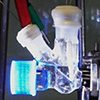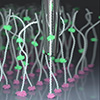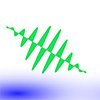Jun 20, 2023 (Nanowerk News) Pangolins are fascinating creatures. This animal looks like a walking pine cone, as it is the only mammal completely covered with hard scales. The scales are made of keratin, just like our hair and nails. The scales overlap and are directly connected to the underlying...
Researchers have 3D printed the world’s smallest wineglass using a new technique
Jun 20, 2023 (Nanowerk News) Researchers have 3D-printed the world’s smallest wine glass—nearly indistinguishable with the naked eye—with a rim smaller than the width of a human hair. But the idea wasn’t to cater to extremely light drinkers. Rather, the glass was printed to demonstrate a new simplified technique for...
Open-source software to speed up quantum research
Jun 20, 2023 (Nanowerk News) Within a few decades, quantum technology is expected to become a key technology in areas such as health, communication, defence and energy. The power and potential of the technology lie in the odd and very special properties of quantum particles. Of particular interest to researchers...
Observations of high-mass star seeds defy models
Jun 20, 2023 (Nanowerk News) Astronomers have mapped 39 interstellar clouds where high-mass stars are expected to form. This large data set shows that the accepted model of low-mass star formation needs to be expanded to explain the formation of high-mass stars. This suggests the formation of high-mass stars is...
New research on self-locking light sources presents opportunities for quantum technologies
Jun 19, 2023 (Nanowerk News) In a paper published in Nature Communications ("Asynchronous locking in metamaterials of fluids of light and sound"), researchers from the Paul Drude Institute in Berlin, Germany, and the Instituto Balseiro, Bariloche, Argentina, demonstrated that light emitters with different resonance frequencies can asynchronously self-lock their relative...
Making the blue shine brighter and longer
Jun 19, 2023 (Nanowerk News) Organic light-emitting diodes are used in smart phones, tablets, and large TV screens. As they do not need any additional background illumination, they are energy-efficient. The can be produced at low costs by thin-film technology and also work on flexible carrier materials, thus enabling bendable...
CRISPR tool with Big Data visualization platform developed for genome editing and modification
Jun 19, 2023 (Nanowerk News) The Hefei Institutes of Physical Science of the Chinese Academy of Sciences (CAS) has spearheaded the development of a novel analysis service platform named CRISPRimmunity. This interactive web server has been constructed to identify and understand crucial molecular events linked to CRISPR and the regulatory...
Clean, sustainable fuels made ‘from thin air’ and plastic waste
Jun 19, 2023 (Nanowerk News) Researchers have demonstrated how carbon dioxide can be captured from industrial processes – or even directly from the air – and transformed into clean, sustainable fuels using just the energy from the Sun. The researchers, from the University of Cambridge, developed a solar-powered reactor that...
Researchers control individual molecules for precision sensing
Jun 19, 2023 (Nanowerk News) Aleksandra Radenovic, head of the Laboratory of Nanoscale Biology in the School of Engineering, has worked for years to improve nanopore technology, which involves passing a molecule like DNA through a tiny pore in a membrane to measure an ionic current. Scientists can determine DNA’s...
photon pairs compress an electron beam into short pulses
Jun 19, 2023 (Nanowerk News) Physicists at the University of Konstanz generate one of the shortest signals ever produced by humans: Using paired laser pulses, they succeeded in compressing a series of electron pulses to a numerically analyzed duration of only 0.000000000000000005 seconds. Processes in nature that occur in molecules...










